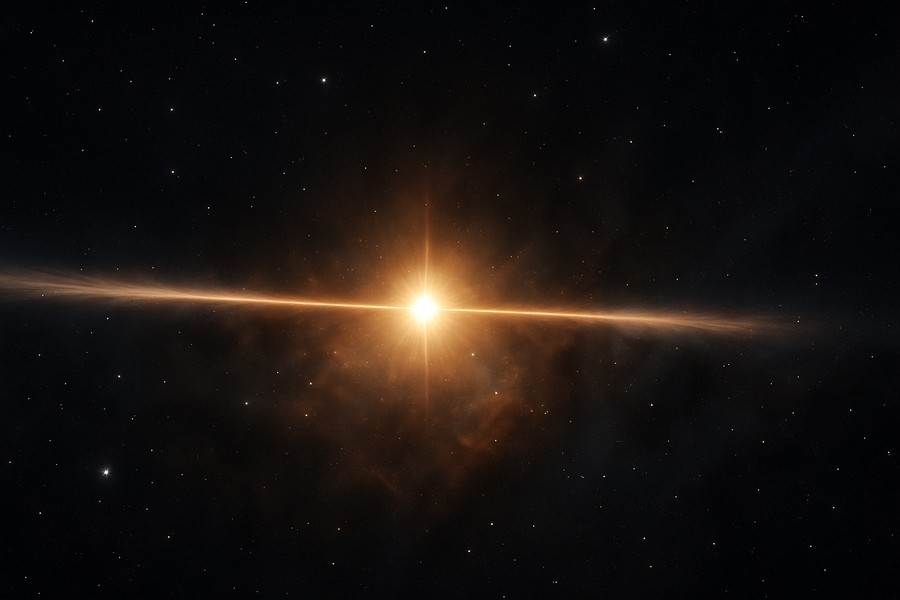
Enormous Star Captured Emitting Twin Jets Across the Cosmos
A gigantic star far away in our galaxy has been captured in an image. It's dramatically discharging a potent cosmic blowtorch, thanks to the Near-Infrared Camera of a renowned space telescope.
The telescope has snapped a unique image of two jets being forced into the interstellar medium that surrounds them. They are creating a nebulous formation known as Sh2-284. These jets span a total of eight light-years as they spread at a speed of hundreds of thousands of miles per hour. Their existence is a testament to the process through which the largest stars in the universe come into being.
Studying Massive Star Formation
Upon discovering a massive star spewing such jets, scientists realized they could use this observation to validate theories on the formation of massive stars. Stellar jets are often seen being emitted by smaller stars during their formation. The jets are powered by material, primarily hydrogen gas, that descends onto the growing star. This material accumulates into a disk around the young protostar.
Parts of the disk material get absorbed by the star, leading to an increase in its mass. However, when the disk gets too crowded, some of the surplus is thrown away by intense magnetic fields that channel the material into two jets along the young star's axis.
Theories of Star Formation
The formation of low-mass stars occurs in a fairly orderly manner. However, there is a theory that the formation of more massive stars, the kind that go supernova, is more chaotic due to the accretion of infalling gas. If this were true, the star and its accretion disk would wobble, causing the jets to move, twist, and spray across a larger area.
Yet, the image of Sh2-284 shows no signs of the jets having moved. They remain straight and nearly 180 degrees apart, suggesting that the formation of the star has been anything but chaotic. The size of the jets, according to models of star formation, corresponds to the size of the star producing them.
Understanding the Jets
These models suggest that the star is about ten times the size of the sun and still growing, and has been powering this outflow. The energy of these jets, their straightness, how narrowly focused they are, and their age can all provide important clues for astronomers to better understand the environment in which the stars that generate these jets form, as well as the intrinsic properties of such stars.
Before this observation, it was not known that a massive star with such a super-jet existed. Such a remarkable outflow of molecular hydrogen from a massive star is a rare occurrence in other regions of our galaxy.
A Unique Location
This young star is situated 15,000 light-years from Earth at the very edge of the Milky Way's spiral disk. Here, the presence of elements heavier than hydrogen and helium is minimal. This is because these elements are created within stars, and star-formation at the edge of the galaxy hasn't been intense enough to produce many of these elements, which are often referred to as "metals" by astronomers.
Discovering a star forming in this environment with low metallicity is a lucky break for astronomers. These conditions mimic those found in the early universe, and this massive star can be used to study the cosmic history.
The Star's History
The oldest part of the jets are their tips, which chronicle the life of the young star. The material at the tips was once close to the star but has propagated out over 100,000 years.
The bright star continues to grow, even though it's not directly visible. The bright stars with diffraction spikes are closer to us in the foreground. However, the telescope can trace the structure of Sh2-284, with filaments, knots, bow shocks, and linear chains of clumpy material all emerging from the jets' interactions with the surrounding interstellar medium.
Despite the power of these jets and the nebulosity they produce, they are only temporary. Eventually, the star will emerge from its cocoon, fully grown with possibly tens of times the mass of our sun. Its lifespan will be limited to a few million years. Then, it will explode, creating a brand-new nebula, one of star-death, not birth, but its legacy will be to enrich space with the metals that it created.
The cycle of stars will carry on.
